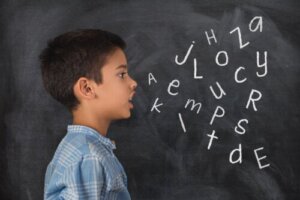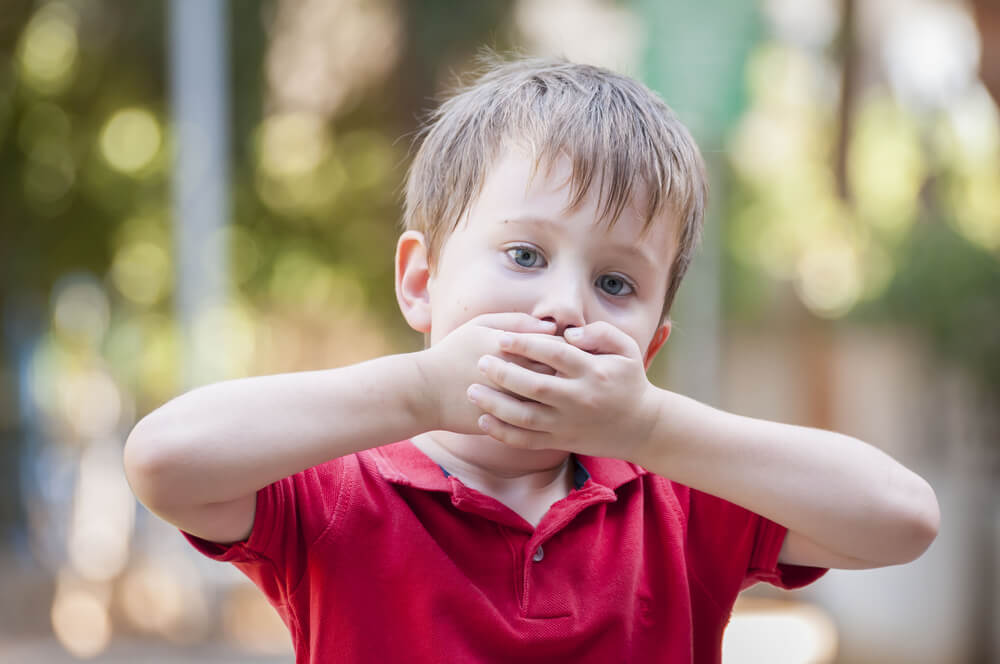What Are the Causes of Stuttering?

Speech begins with a babble and then becomes more complicated with syllables and word combinations. But when should the sudden interruption of an idea be a cause for concern? When does the repetition of a syllable signal that there’s more to it? The arrival of speech in children is usually eagerly awaited by parents and their environment, and this causes them to live with very particular attention (and tension!). However, occasional stuttering is more frequent than we think, although it’s important to be aware of some warning signs.
Keep reading and find out more.
What is stuttering and what are its causes
Stuttering is a verbal fluency disorder that’s evident in the rhythm of speech. As a consequence, repetitions, prolonged verbalizations, difficulties in starting a sentence, or sudden stops occur.
Although in most cases, the person knows what they want to say, this situation produces discomfort and pressure. Therefore, the attempt to communicate implies a greater effort. Therefore, behavior may arise to avoid such a situation, which causes withdrawal, inhibition, or embarrassment.
Dysphemia -also known as stuttering- usually begins around the age of 3 years. It’s at this stage that most children are able to combine several words to express themselves. This disorder occurs in up to 5% of the child population.

The causes of stuttering
Most research reports that stuttering isn’t due to a single cause, but to the interaction of multiple factors. While these aren’t entirely clear, genetic, physiological, or psychological origins are attributed to the disorder:
- Genetic causes: When there’s a history of stuttering in first-degree relatives, there’s a high probability of suffering from it.
- Physiological causes: These refer to some inconveniences or alterations in the motor control of speech that involve difficulties in motor coordination, the management of time, and sensory aspects.
- Psychological causes: Dysphemia may also develop as a result of a traumatic experience.
To these causes, stuttering should be added as a consequence of other types of problems, such as having suffered a stroke.
At the same time, as Sangorrin (2005) points out, the vast majority of people who stutter don’t have any psychopathological condition, nor do they have a particular psychological profile. What’s been detected is comorbidity with Down syndrome or anxiety disorders.
You may be interested in: Children’s Anxiety Symptoms that You Shouldn’t Overlook
How to differentiate stuttering from other speech difficulties?
Ordering ideas, concentrating on what we say, and making ourselves understood are acts that can be extremely difficult, especially for those who are learning to speak. Most of the time, these are usually temporary difficulties that disappear with practice. However, it’s also true that early detection allows for a timely and less frustrating approach for the child. So, let’s look at some signs of transient stuttering and others that require close monitoring.
You should pay more attention to behaviors such as the following:
- When the child expresses a certain tension or nervousness when speaking. That’s to say, when they make an extra effort.
- If certain tics, movements, tapping or playing with the hands, lip tension, or avoidance of eye contact appear.
- If fluency problems persist for more than 6 months.
- If there’s a family history of stuttering.
- If it occurs with other speech or language development problems.
You shouldn’t be alarmed if your child…
- Use some crutches or filler words. For example, “ummm”.
- Had fluency problems, but overcame them before 6 months of age.

What can we do about stuttering?
Stuttering often causes nervousness and leads to inhibition in communication situations. For example, the child may refuse to be the one to initiate a conversation or may limit themself to expressing only what they deem necessary. However, as interlocutors, we can help to prevent this from happening and foster a favorable environment for the child to feel calm and be able to express him/herself.
Some of the recommendations to help children with stuttering are the following:
- Encourage them to practice speaking. For example, they can do this through soliloquies. This way, they practice trial and error and face a feared situation, but without the consequences and discomfort that comes with being in front of other people.
- Respect their time and be patient. In addition to showing assertiveness, it also involves empathetic and respectful actions, such as avoiding completing sentences for them.
- Be an example as a speaker. For example, speak slowly and completely.
You may be interested in: What Are Simple Language Delays?
Stuttering involves much more than speech
Raising awareness about the importance of addressing stuttering goes hand in hand with repairing the psychological and social consequences it produces when it’s chronic. Some of them are insecurity, low self-esteem, isolation, and withdrawal.
Like all difficulties, there’s a component of social responsibility that concerns us. Both at school and at home, children should be taught to help those who have difficulty speaking instead of making fun of them. It’s also a matter of disarming prejudices and, instead, providing information on the subject. This is the only way to create a favorable environment for communication to be more pleasant and less hostile.
Speech begins with a babble and then becomes more complicated with syllables and word combinations. But when should the sudden interruption of an idea be a cause for concern? When does the repetition of a syllable signal that there’s more to it? The arrival of speech in children is usually eagerly awaited by parents and their environment, and this causes them to live with very particular attention (and tension!). However, occasional stuttering is more frequent than we think, although it’s important to be aware of some warning signs.
Keep reading and find out more.
What is stuttering and what are its causes
Stuttering is a verbal fluency disorder that’s evident in the rhythm of speech. As a consequence, repetitions, prolonged verbalizations, difficulties in starting a sentence, or sudden stops occur.
Although in most cases, the person knows what they want to say, this situation produces discomfort and pressure. Therefore, the attempt to communicate implies a greater effort. Therefore, behavior may arise to avoid such a situation, which causes withdrawal, inhibition, or embarrassment.
Dysphemia -also known as stuttering- usually begins around the age of 3 years. It’s at this stage that most children are able to combine several words to express themselves. This disorder occurs in up to 5% of the child population.

The causes of stuttering
Most research reports that stuttering isn’t due to a single cause, but to the interaction of multiple factors. While these aren’t entirely clear, genetic, physiological, or psychological origins are attributed to the disorder:
- Genetic causes: When there’s a history of stuttering in first-degree relatives, there’s a high probability of suffering from it.
- Physiological causes: These refer to some inconveniences or alterations in the motor control of speech that involve difficulties in motor coordination, the management of time, and sensory aspects.
- Psychological causes: Dysphemia may also develop as a result of a traumatic experience.
To these causes, stuttering should be added as a consequence of other types of problems, such as having suffered a stroke.
At the same time, as Sangorrin (2005) points out, the vast majority of people who stutter don’t have any psychopathological condition, nor do they have a particular psychological profile. What’s been detected is comorbidity with Down syndrome or anxiety disorders.
You may be interested in: Children’s Anxiety Symptoms that You Shouldn’t Overlook
How to differentiate stuttering from other speech difficulties?
Ordering ideas, concentrating on what we say, and making ourselves understood are acts that can be extremely difficult, especially for those who are learning to speak. Most of the time, these are usually temporary difficulties that disappear with practice. However, it’s also true that early detection allows for a timely and less frustrating approach for the child. So, let’s look at some signs of transient stuttering and others that require close monitoring.
You should pay more attention to behaviors such as the following:
- When the child expresses a certain tension or nervousness when speaking. That’s to say, when they make an extra effort.
- If certain tics, movements, tapping or playing with the hands, lip tension, or avoidance of eye contact appear.
- If fluency problems persist for more than 6 months.
- If there’s a family history of stuttering.
- If it occurs with other speech or language development problems.
You shouldn’t be alarmed if your child…
- Use some crutches or filler words. For example, “ummm”.
- Had fluency problems, but overcame them before 6 months of age.

What can we do about stuttering?
Stuttering often causes nervousness and leads to inhibition in communication situations. For example, the child may refuse to be the one to initiate a conversation or may limit themself to expressing only what they deem necessary. However, as interlocutors, we can help to prevent this from happening and foster a favorable environment for the child to feel calm and be able to express him/herself.
Some of the recommendations to help children with stuttering are the following:
- Encourage them to practice speaking. For example, they can do this through soliloquies. This way, they practice trial and error and face a feared situation, but without the consequences and discomfort that comes with being in front of other people.
- Respect their time and be patient. In addition to showing assertiveness, it also involves empathetic and respectful actions, such as avoiding completing sentences for them.
- Be an example as a speaker. For example, speak slowly and completely.
You may be interested in: What Are Simple Language Delays?
Stuttering involves much more than speech
Raising awareness about the importance of addressing stuttering goes hand in hand with repairing the psychological and social consequences it produces when it’s chronic. Some of them are insecurity, low self-esteem, isolation, and withdrawal.
Like all difficulties, there’s a component of social responsibility that concerns us. Both at school and at home, children should be taught to help those who have difficulty speaking instead of making fun of them. It’s also a matter of disarming prejudices and, instead, providing information on the subject. This is the only way to create a favorable environment for communication to be more pleasant and less hostile.
All cited sources were thoroughly reviewed by our team to ensure their quality, reliability, currency, and validity. The bibliography of this article was considered reliable and of academic or scientific accuracy.
- Sangorrín, J. (2005). Disfemia o tartamudez. Revista de neurología, 41(1), 43-46.
- Humaní Gallegos, G. A. (2012). Características clínico-epidemiológicas de la tartamudez en niños de 3 a 10 años atendidos en el Instituto Nacional de Rehabilitación durante el periodo 2008-2010.
- Guardia Arce, Karol Stephany, Garrón Prado, Mayerlin, & Guzmán Rojas, Arantxa Valeria. (2021). Disfluencia fisiológica en edad preescolar. Revista Científica de Salud UNITEPC, 8(1), 45-56. Epub 30 de junio de 2021.https://doi.org/10.36716/unitepc.v8i1.77
This text is provided for informational purposes only and does not replace consultation with a professional. If in doubt, consult your specialist.








